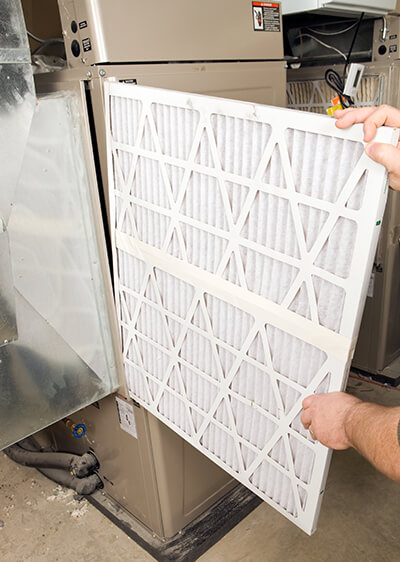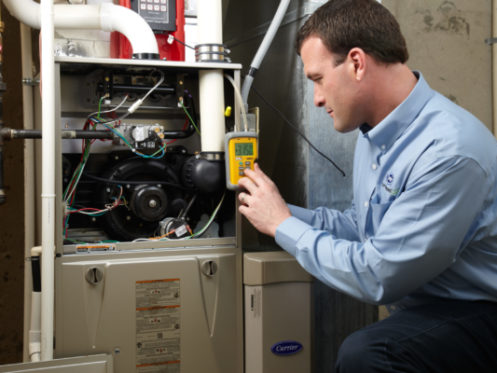If you’re like most homeowners, you know that you need to provide fuel for your furnace to heat your home. However, beyond that, do you really know what’s all involved in efficient furnace operation? It can be highly beneficial to understand the various processes that your furnace goes through to heat your home so that you can make more informed decisions about future repairs and equipment purchases.
A Quick History Recap
Other than fireplaces, furnaces are one of the oldest methods that homeowners have utilized to heat their homes during the colder winter months. Older versions used wood and coal as fuel to create heat. Nowadays, many homeowners rely on propane, natural gas, heating oil, and electricity to produce the heat that they need.
Running Process
At the very start of any furnace heating cycle, your thermostat will signal to your furnace that it needs to turn on. Your thermostat is responsible for monitoring the temperature inside of your home and signaling to the furnace that it’s time to kick on whenever the temperature is below what your desired settings are.
Once your thermostat has signaled for a heating cycle to begin, the burners inside of your furnace are lit. Depending on the type of fuel that you utilize, this can be done in a couple of different ways. Many new gas and heating oil furnaces use a direct ignition spark, while older furnaces utilize a pilot light to light the burner. If you have an electric furnace, there are actually heating coils inside of the main cabinet that will start to heat up.
Once the burner is lit, it will start to burn the fuel and produce heat. This heat is forced into the heat exchanger. More modern systems will have a motor that will force air into the heat exchanger, while older furnaces rely on the natural rise of the heat to force it into the heat exchanger.
Once the heat is in the heat exchanger, the blower motor will turn on. The blower motor is responsible for forcing the hot air through the air ducts in your home and out through the vents. A separate blower motor will pull cold air throughout your home into your ductwork and through your furnace to heat it up.
During this heating cycle, there will be exhaust fumes that are produced from the combustion of gas or oil. Toxic exhaust fumes are vented via the flue and vent pipes to the outside of your home. Once your thermostat senses that the ambient temperature inside of your home has reached the desired temperature that you have set on the thermostat, it will signal to your furnace to shut off.
Different Furnace Types
Now that you understand how a basic furnace operates, it’s important to get a little more specific about the different types of furnaces that you can have in your home. There are three main types which include the single-stage, two-stage, and variable-speed furnaces. Each specific type operates a bit differently from the next.
Single-Stage Furnace
Most single-stage furnaces are fairly older as most newer furnaces are geared towards two-speed and variable-speed operation. With a single-stage furnace, the valve for the fuel supply will be completely opened when the furnace is on so that it can produce heat on full blast. Simply put, with a single-stage furnace, your system is working at maximum capacity while it’s on.
Two-Stage Furnace
The more modern option, a two-stage furnace, has a three-position fuel valve. It has settings that include on, partially closed, and fully closed. When your furnace kicks on, it will choose between the partially closed and on stages, depending on the specific temperature request. If your system is just looking to add a couple of degrees, it will operate in a partially closed state where it runs at 65% of its maximum capacity.
When the partial operation isn’t sufficient enough for your heating needs, a two-stage furnace will switch to a completely open valve that will have your furnace operating at maximum capacity. The whole idea behind two-stage furnaces is that they can operate more efficiently depending on the temperature needs of your home as compared to a single-stage furnace.

Variable-Speed Furnace
Lastly, we have the variable-speed furnace. Instead of having different settings at its fuel valve, a variable-speed furnace changes its operating capacity via an adjustable fan motor. These variable-speed blower motors can operate at different speeds to control the flow of warm air throughout your home to create a better balance of temperature and humidity.
Furnace Heating Methods
It’s important to note that how your furnace operates is going to vary a little bit depending on the specific type of method that you use for it. There are three main methods that can be utilized to heat your furnace. These include gas, electricity, and oil.
Gas Furnace
The term gas furnace can refer to a furnace that burns propane or natural gas. These are the most common types of furnaces on the market today, and they can last anywhere between 15 and 20 years. An added benefit to having a natural gas burning furnace is that you typically don’t have to have a storage tank on site as you get the natural gas pumped into your home via city piping.
Electric Furnace
Instead of utilizing gas or oil to create heat, electric furnaces run on electricity to warm up your home. This type of system has electrical heating elements inside of it that work to heat up the air which is distributed throughout your home. Electric furnaces have a life expectancy of about 20 to 30 years. This type of system doesn’t require any sort of exhaust venting as there are no toxic fumes created from combustion.
Heating Oil Furnace
Another popular furnace option is the oil-burning furnace. This type of furnace requires the homeowner to keep an on-site oil storage tank that will typically need to be refilled multiple times throughout the winter season. This type of furnace can last more than 20 years if you properly maintain it.
How to Keep Your Furnace in Great Working Condition
Whenever you notice that there is a problem with how your furnace is operating, it’s important that you speak to an HVAC professional right away to prevent any further damage from happening to your system. When you follow these key guidelines for proper furnace maintenance, you can ensure that your system lasts its intended lifespan.
Reliable Heating Services
F.F. Hitchcock Plumbing, Heating & Cooling provides reliable heating services to the whole Cheshire, CT community. We also offer top-quality cooling services, fuel services, and plumbing services. There are also service plans available. Simply contact F.F. Hitchcock Plumbing, Heating & Cooling today to get the professional help that you need.








